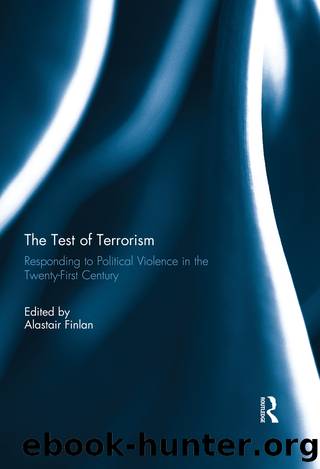The Test of Terrorism by Alastair Finlan

Author:Alastair Finlan [Finlan, Alastair]
Language: eng
Format: epub
ISBN: 9781317653363
Barnesnoble:
Publisher: Taylor & Francis
Published: 2016-01-13T00:00:00+00:00
European Union members: CT spending
For various countries, terrorism has been a secondary or law enforcement issue. However, for a few European states, the threat from terrorism has been a long-standing condition (UK, Spain, France, Germany, and Italy). For others (Netherlands, Norway), the threat of terrorism has become a more recent phenomenon post-9/11 and thereby an emerging national priority. Until recently, the EU did not possess an integrated CTapproach.40
The EUâs CT policy that emerged following the 9/11 attacks in the USA had only minimal coordinated interstate and interagency activity.41 Indeed, while a few legal and bureaucratic steps were taken â a Justice and Home Affairs Council meeting was held on the 20 September 2001 to establish a few security and other measures to combat terrorism â very little in the way of serious funding or the creation of agencies on par with what was done in the USA occurred.
Following attacks in Madrid Spain in March 2004 and London in July 2005, however, the EU began to reexamine its institutional role in addressing CT in Europe.42 The EU took various steps to expand its policing ability with the strengthening of Europol and its prosecution ability and doing the same for Eurojust.43 By 2007, as part of this new effort, Europol became one of the leading agencies in Europe tasked with CT. Prior to that there were other efforts for greater transatlantic cooperation. The EU enacted agreements with the US Department of Justice in 2006 to strengthen CT information exchange between the two agencies. By 2008, Council Decision replaced the Europol Convention. This meant that along with already having powers that allowed Europol greater flexibility to tackle cross-border problems such as âillegal migration, drug trafficking, trafficking in human beings, terrorism and organized crime,â the agency would now be financed from the Community budget.44
Despite these efforts, the yearly expenditure on CT in all European countries fell well below that of the USA. For many outside observers, the degree of financial investments toward CT seem relatively insufficient, especially in light of the threat several members of the EU have historically faced. Accordingly, EU members recently attempted to increase their perceived lax spending on CT by providing greater allocations for âfighting crime and radicalization,â which include immigration restrictions to monitor and deny entry into Europe of known or suspected terrorists:
EU Counterterrorism Strategy and have made great efforts to fight terrorism under the four main pillars of the European Union Counterterrorism Strategy: prevent (1) protect (2) pursue (3) respond (4). They have also increased their international cooperation in the fight against terrorism (5) . . .For the next period of the Multiannual Financial Framework (2014â2020), the Commission has proposed an overall Home Affairs budget of ¢10.7 billion (an increase of almost 40 percent compared to the period 2007â2013). While the amount of funding will increase, the number of funds will be reduced from six to two: A new Asylum and Migration fund with an overall budget of ¢3,869 million and a new Internal Security fund worth ¢4,648 million.
Download
This site does not store any files on its server. We only index and link to content provided by other sites. Please contact the content providers to delete copyright contents if any and email us, we'll remove relevant links or contents immediately.
The Radium Girls by Kate Moore(11921)
100 Deadly Skills by Clint Emerson(4840)
Rise and Kill First by Ronen Bergman(4701)
The Templars by Dan Jones(4627)
The Doomsday Machine by Daniel Ellsberg(4415)
The Rape of Nanking by Iris Chang(4136)
Killing England by Bill O'Reilly(3951)
Hitler in Los Angeles by Steven J. Ross(3900)
Stalin by Stephen Kotkin(3875)
12 Strong by Doug Stanton(3508)
Hitler's Monsters by Eric Kurlander(3268)
Blood and Sand by Alex Von Tunzelmann(3138)
The Code Book by Simon Singh(3073)
Darkest Hour by Anthony McCarten(3070)
The Art of War Visualized by Jessica Hagy(2943)
Hitler's Flying Saucers: A Guide to German Flying Discs of the Second World War by Stevens Henry(2714)
Babylon's Ark by Lawrence Anthony(2620)
The Second World Wars by Victor Davis Hanson(2480)
Tobruk by Peter Fitzsimons(2443)
